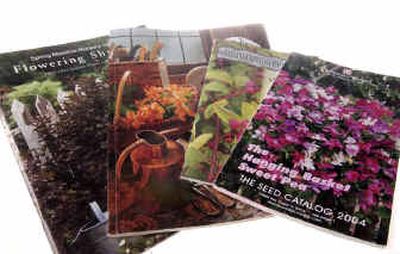Garden Guides

Nearly every day now, more garden catalogs show up in the mailbox. For serious plant people, that means everything gets dropped until the latest arrival is checked out for “must have” plants. Just ask Sherrie Giles and Phyllis Hathaway. These two Spokane landscape designers compare notes and place joint orders from their favorites. Ordering 100 plants at a shot is not uncommon for these avowed plantaholics. They also get together with a group of their like-minded friends on a winter afternoon to trade catalogs.
“Someone always has one that someone else hasn’t seen,” says Hathaway.
There are literally hundreds if not thousands of catalogs out there to tempt gardeners. Many of them attract us with perfect pictures and a promise that no matter how much gardening experience we have, we can create a wonderful garden. Others like Hathaway’s and Giles’s favorite, Dan Hinkley’s Heronswood Nursery catalog, are basically encyclopedias of rare and unusual plants that are as much a reference tool as a buying mechanism.
“For the longest time, I have always just gotten ahold of the catalog and studied them,” says Hathaway. “That’s how I learn a lot about plants, what’s out there and new and great. The way (Dan Hinkley) describes the plants is just hilarious. It’s fun to read. Mind you this catalog doesn’t have pictures.”
The rise of the Internet has added a whole new dimension to mail order gardening. Hathaway says that quite often, “The Web site is more current than if you get their printed catalog.” With the Internet, a company can list special sales or offer groups of plants that became available after the catalog was produced, sometimes giving consumers much better deals. They can also add several pictures of the same plant instead of the single one in the catalog, and that can make it easier for planters to decide whether this specimen will work in their yard.
The Internet also makes it easier to find catalogs you haven’t seen before, or to check out customer satisfaction information.
Two of my favorite sites are www.gardenguides.com/catalogs for customer ratings of a number of garden catalogs, and www.mailordergardening.com for a very comprehensive list of catalogs offered by trade members of the Mailorder Gardening Association.
With all these choices, what really makes a good catalog?
For starters, ignore the pretty pictures. Look for notes on hardiness or days to maturity. For perennials, shrubs and trees, this should be expressed as the USDA zone designation or a temperature range. The Inland Northwest is either USDA Zones 4 (-30 to -20 degrees) or 5 (-10 to -20 degrees).
“Trash a catalog if they aren’t going to tell you the zone,” says Hathaway.
Vegetable catalogs should list the expected days to maturity for each variety. This means the time it takes to produce ripe fruit after the seed has been planted or transplants are set out. This is critical for our region because of our short growing season.
“A good catalog should give you a little dissertation about growing conditions like sun, shade, stay out of wind,” Hathaway said.
Also, the plant description should tell you about the type of soil the plant prefers, sun and/or shade requirements, watering needs, and special notes about resistance to disease. Some catalogs will indicate which plants are deer and critter resistant or attract birds or butterflies.
The catalog should list a scientific name along with the common name so you know exactly which plant you are getting. It’s not uncommon for a plant to have several common names or for several plants to have the same common name.
Catalogs offering live plants have mushroomed with the development of fast delivery services that can get plants to your door overnight. The ordering information in a catalog should be specific about when they ship to your hardiness zone so the plants arrive at the best time to plant.
“Most good growers know my zone and they don’t send me anything until the first of May,” said Hathaway. “Other growers ask me when I want them shipped.”
Be sure to unpack your plants as soon as they arrive. Most growers pack the plants so they stay moist in transit.
“Usually they will come wrapped with newspaper and that holds in moisture and then they are wrapped in plastic,” Hathaway said.
The live plants that arrive on your doorstep will not look like the pictures. Most plants have to be dormant when they are shipped so they will be no more than seemingly lifeless bare sticks and roots. And they are often smaller than those you would buy in the local nursery.
Small size plants have their advantages says Giles. “I’ve had really good luck with the plant materials I’ve ordered. Usually the growers grow them in deeper containers so they have a much better root system. They are second year plants so they just take off and do very well.”
Both Hathaway and Giles try to plant their new treasures as soon as they arrive to minimize shock that could stunt or kill the plants. “If I can’t plant it right away, I put them either in a cool dark place or if it’s still freezing at night, in the garage. But I usually try to get them in the ground as soon as I can,” said Giles. The longest she has let a shipment sit has been two days.
When ordering live plants, be sure to read the guarantee and return policies carefully. A good catalog will have a very clear policy about returns, mislabeled plants and plants that do not thrive.
Hathaway and Giles do not order all their plants out of catalogs. Both say that unless you are looking for something really unusual or a new introduction you just have to have, you would be time and money ahead to buy the plants and seeds at your local nursery or garden center.